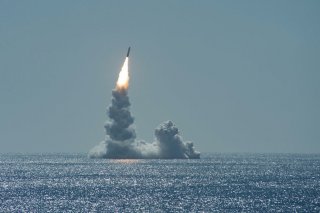This Picture Could Very Well Mean the End of the World (If It Was Not Training)
These nuclear-armed submarines are patrolling the world's waters as we speak.
Key Point: Indeed, these vessel and their payloads could end human civilization in less time than it takes to order a pizza if a third world war were to break out.
While they have thankfully never been used during a shooting war, nuclear-powered submarines carrying nuclear-tipped missiles are the most deadly weapons mankind has ever devised. In some cases—as in the case of the Ohio-class submarine during the height of the Cold War—even a single vessel could reduce as many as 288 city-sized targets into radioactive ash in less than 30 minutes. Indeed, these vessel and their payloads could end human civilization in less time than it takes to order a pizza if a third world war were to break out.
In this article, we have picked five of the most capable nuclear-armed submarines that are either in service or will soon enter service. Older vessels such as the Soviet Union’s massive Project 941 Akula—known in the West as the Typhoon—are not included because those vessels have been largely retired and dismantled. Only Dmitriy Donskoy remains in service with the Russian Navy as a test vessel stripped of her ballistic missile armament.
Ohio-class Ballistic Missile Submarine
The United States Navy’s Ohio-class ballistic missile submarine can carry 24 UGM-133 Trident II D5 submarine launched ballistic missiles that can each carry as many as twelve W88 475 kiloton thermonuclear warheads. With the sheer accuracy of the Mk5 reentry vehicle, which has a circular error of probability of less than 90 meters, the Ohio-class and its Trident II missiles have the capability to be used as first strike weapons. Under the 2010 Nuclear Posture Review, the United States expects to maintain a total of 14 Ohio-class submarines, with two in repair at any given time. These days, each Ohio carries 20 missiles for a total fleet of 240 deployed Trident IIs. As of 2016, nine Ohio-class submarines are deployed in the Pacific while another five are assigned to the Atlantic.
Columbia-class Ballistic Missile Submarine
The Ohio-class submarine is an aging design despite its formidable capabilities and the first of the class are reaching the end of their 42-year service lives. To replace the Ohio-class, the United States Navy is building the new Columbia-class boomer. The new SSBNs are slightly larger than the Ohio-class at a displacement of 20,800 tons, but the vessels only have 16 Trident II D5 missiles onboard. Most of the vessels’ massive size is taken up by a new life-of-the-boat reactor and permanent magnet motor drive, which while extremely quiet, is also enormous. The new vessels are largely based on technology from the Virginia class attack submarines and leverages many of the smaller boats’ systems. Indeed, in some respects, the Columbia is an enlarged advanced derivative of the excellent Virginia-class design. Construction will start in 2021 while the first boat will enter service in 2031.
Project 955 Borei-class Ballistic Missile Submarine
Not to be out done, America’s Cold War adversary—though severely reduced in its military might—maintains parity in exactly one area with the United States: Nuclear Weapons.
Thus, it should come as no surprise that Russia is building a fleet of extremely capable new Project 955A Borei-class ballistic submarines. Smaller than their gargantuan Project 941 Akula aka Typhoon-class predecessors, at a displacement of 24,000 tons, the Borei is larger than the Ohio or Columbia, but is not quite as capable as the American vessel. Nonetheless, the Boreis are the quietest Russian ballistic missile submarines built to date and incorporates pumpjet propulsor technology. The vessels carry sixteen RSM-56 Bulava submarine launched ballistic missiles—each with as many as 10 nuclear warheads at a range of 8,000 kilometers. The warheads have an accuracy of between 250m and 300 m CEP and are designed to evade missile defenses.
Project 667BDRM Delfin class (Delta IV) Ballistic Missile Submarine
Built at the same time as the mighty Typhoon-class, the Delta IV is the current backbone of the Russian ballistic missile submarine fleet. The older 18,200-ton Delta IV design is nonetheless a capable platform and its armed with 16 R-29RMU Sineva liquid-fuel ballistic missiles, each of which can carry between four and eight warheads. Unlike previous versions of the Project 667 design, the Delta IV is able to fire missiles in any direction from a constant course in a circular sector. It is also able to fire its ballistic missiles from a depth of 55 meters while cruising at a speed of six to seven knots.
Project 885M Yasen class Guided Missile Submarine
The Severodvinsk-class nuclear-powered guided missile submarine is not a ballistic missile submarine, but with a payload of 32 dual nuclear/conventional capable 3M-14K Kalibr cruise missiles that have a range of over 2500 kilometers, the Project 885M boats are a threat to the U.S. homeland. The Yasen class is fast and extremely quiet and has extremely potent sensors—if the U.S. Navy’s Office of Naval Intelligence is correct in its assessment of the boats. There is every expectation that the Severodvinsk or her sister Kazan could easily close to 2000km off the American east coast and strike inland as far as the Great Lakes. Indeed, if the vessel—and given its impressive stealth it could—close to within 1000Km or less, it could like as far inland as Chicago or even St Louis.
This article appeared earlier this year and is reprinted due to reader interest.
Image: Flickr.

